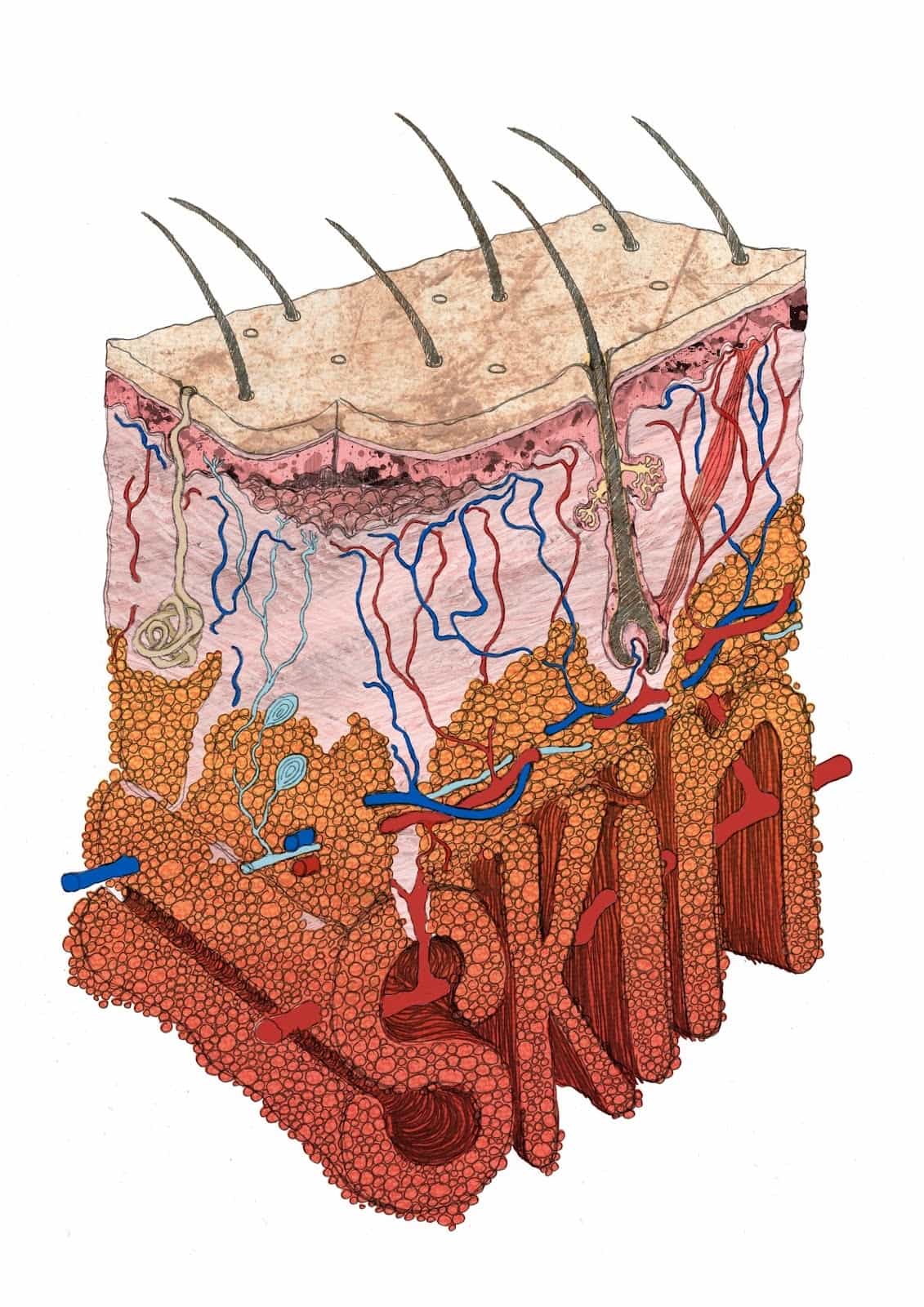We always welcome inquiries from customers seeking to better understand products and what skin care routines might be the best for them. Aging, mature skin needs an entirely different approach to products as compared to the youthful, pump, collagen healthy skin of youth.
What is Skin Barrier Function?
The skin isn’t just a covering keeping our insides from spilling out. It is composed of 3 distinct layers with different purposes. We have the top layer, the Epidermis, the middle layer or Dermis and the lower layer or Hypodermis.
In skin care, we are most often concerned with the visible Epidermis. The very top layer that you see and feel is called the Stratum Corneum. This layer consists of up to 20 layers of flattened, hard dead skin cells. These dead skin cells (corneocytes) are embedded in a lipid mixture of (15%) fatty acids, (25%) cholesterol, (50%) ceramides and keratin. We shed skin cells from this layer all through the day, usually unaware it is happening.
The Stratum Corneum provides what is called the Skin Barrier Function. This layers protects us from dehydration, chemicals, UV rays, bacteria, viruses and other environmental onslaughts. Less informed yet well meaning skin care entrepreneurs tell their customers that the skin absorbs 60% (or more) of the ingredients rubbed on the skin. The attempt being to guide customers away from artificial or ingredients other than what they are selling using fear. We prefer to help you by sharing the following:
Skin Barrier Function PART 1
In reality, the amount the skin will absorb is dependent upon a multitude of factors including:
- Water: How hydrated is the person? Do they drink water, soda pop, tea or coffee and how much?
- Diet: A higher quality diet has been shown to strengthen barrier function whereas a poor-quality diet will weaken it.
- Medication: Some medications, particularly pain pills can be very dehydrating. The use of diuretics impact the moisture content of the skin as well.
- Exercise: The activity level of the person has a direct effect on the skins need to absorb.
The ability of the skin to absorb ingredients is innately tied to all the above. Any and all of these effect how much the skin will absorb at any given point during the day, so to say the skin absorbs 60%, 80%, 90% of what it comes into contact is inaccurate to say the least.
Skin Barrier Function PART II
We had a customer asking if the coconut and palm fruit oil in our soap would impact her cholesterol levels, as she had heart issues. At first I was surprised by the question, but then I realized it could be a real concern to those with health conditions.
Once again that wonderful Barrier Function comes into play. In order for any product to enter the bloodstream through the skin, it has to be of a very small molecular size. Essential oils are a good example of what can be applied to skin and will find their way into the bloodstream. Essential oils are so small they are measured in microns. This is how and why they work on a variety of conditions.
However in soap, the fatty acids (coconut, olive, palm fruit, etc) are saponified. They are converted from their fatty acid state into SOAP, completely changing their molecular structure. Soap molecules are quite large and while they work in concert with water, they themselves do not enter and reside in the skin. Because soap is hydrophilic (water loving), it is suspended with the water molecules and washes off the body, taking the dirt, sebum, oils and dead skin cells with them. Soap affects the SURFACE of the Stratus Corneum and helps to remove dead layers. Goat Milk Soap has natural alpha hydroxy acid which further loosens debris and softens the skin
Lastly, the Barrier Function has another critical function. It is to keep water IN the body and protect against dehydration. This has a double benefit. While it keeps water in, it also limits the amount of water that can GET in. Were it not for the Barrier Function, the body would swell like a sponge when we went swimming absorbing all the water it could.
So armed with your new “barrier function” knowledge, appreciate the vast complexity and amazing abilities of the largest organ in the body. We’ve briefly touched on only one small aspect of skin anatomy, so let us know if you have found this interesting and of value? If so, we will delve into more skin anatomy written in simple language in coming blogs!
Sources:
- Role of lipids in the formation and maintenance of the cutaneous permeability barrier
Biochimica et Biophysica Acta (BBA) – Molecular and Cell Biology of Lipids, Volume 1841, Issue 3, March 2014, Pages 280–294



Comments
Great info! Keep it coming! Thanks for all you do. We love your products!
Yes, very informative. I have heart issues so this was especially interesting to me. But what do you think of the exfoliating products that so many (and I mean many) people and websites recommend? Is it just to sell products?
Thanks
Judy: It is important to remove dead skin cells periodically, however intense exfoliation isn’t necessary every single day. A gentle exfoliant isn’t a problem, like oatmeal or spices. The neat thing about goat milk soap is that it contains alpha-hydroxy acid which is a natural exfoliant and helps loosen cells without a harsh abrasive. That is one of the reasons the soap is know for creating softer skin. I hope this answers your question! Thanks for asking!